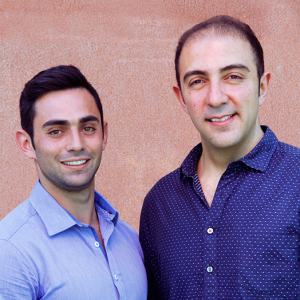A new Australian invention could significantly reduce recovery time for a variety of procedures – great for patients and for the economy.

Terence Abrams and Dr Ali Fathi
Dr Ali Fathi has invented an injectable tissue scaffold to provide implant stability and expedite tissue repair. The invention, enabled by Microscopy Australia, has the potential to reduce surgery healing time from eight weeks to two.
This scaffold, called Tetramatrix (formerly Trimph), is a liquid at low temperatures, making it easy to inject with high precision during surgery. At body temperature it hardens to provide mechanical support. Tetramatrix also contains compounds that signal the body to repair tissues.
Tetramatrix has components that can be customised for a variety of surgical applications. The mechanical and physical properties of the scaffold can be changed to provide different levels of hardness and elasticity, and the compounds carried in the scaffold can be changed to encourage different kinds of tissue to grow. The tissue repair compound can also be targeted to specific tissues types. Their first product, TrimphDent, has successfully completed initial clinical trials for bone healing after tooth extraction.
The entrepreneurial Dr Fathi invented Tetramatrix during his PhD at the University of Sydney. Excited about its medical potential, Dr Fathi licensed the invention from the University and co-founded Trimph Pty Ltd, now Tetratherix, with Terence Abrams. With capital investment secured to commercialise the product and the benefit of NSW Health Medical Device Commercialization training, this exciting startup is based at the Cicada Incubator in Sydney. Trimph Pty Ltd chose Microscopy Australia’s instrumentation and expertise to support R&D from early research through to clinical trials. Environmental scanning electron microscopy was used to study the microstructure of the scaffold in a hydrated state, and transmission electron microscopy was used to test different additives to the scaffold. Confocal microscopy contributed to pre-clinical testing to check that cells could bond and regenerate in the scaffold. They also used X-ray microtomography to monitor tissue regeneration over time and light microscopy to study interactions between cells and the scaffold.
Tetratherix products are are manufactured in a cleanroom facility in Sydney and protected by patents granted in Australia, the US, Japan, Europe and by the World Intellectual Property Organisation (PCT).
Tetratherix secured more than $3.4 million of funding from private and public sources, including $0.7m from Accelerating Commercialisation program funded by Commonwealth in 2017 and $1 million from the NSW Medical Device Fund in 2018.
In March 2020 Tetratherix closed a $5m Series A funding round, backed by Ryder Innovation Fund, a venture capital limited partnership specialising in medtech and tech opportunities. In October 2020, Tetratherix executed a co-development licensing agreement with a leading pharmaceutical company in China to develop drug/device combination products, using Tetratmatrix to access the Asian market.
“Start-ups have to be cognisant of where their money is spent. To have organisations like Microscopy Australia helps with business growth” – Terence Abrams, COO & co-founder of Tetratherix.
August 15, 2016